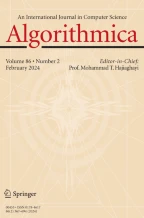Abstract
Ad-scheduling of a graphG is a sequence of rounds, each consisting of some of the nodes of the graph, such that the distance between any two nodes participating in the same round is greater thand. Ad-scheduler is a protocol that determines ad-scheduling ofG. A 1-scheduler is applicable to process scheduling in a resource-sharing system, and to proper communication scheduling of the half-duplex model in communication networks. A 2-scheduler can be used as a collision-free protocol for radio networks.
In this paper a simpled-scheduler is analyzed. We first discuss basic properties of this scheduling, and give a complete characterization of this scheduling for trees and cycles. We study the period length of this scheduling, and the main result is a worst-case exponential lower bound for this length.
Similar content being viewed by others
References
B. Awerbuch, Complexity of network synchronization,J. Assoc. Comput. Mach.,32 (1985), 804–823.
V. C. Barbosa, Concurrency in Systems with Neighborhood Constraints, Ph.D. Dissertation, Computer Science Department, University of California, Los Angeles, CA, 1986.
V. C. Barbosa and E. Gafni, Concurrency in systems with neighborhood constraints,Proc. Conf. on Distributed Computing Systems, 1987, pp. 448–455.
C. T. Chou, I. Cidon, I. Gopal, and S. Zaks, Synchronizing Asynchronous Bounded Delay Networks, RC 12274, IBM T. J. Watson Research Center, Yorktown Heights, NY, October 1986.
I. Chlamtac and S. Kutten, A spatial reuse TDMA/FDMA for mobile multi-hop radio networks,INFOCOM Conf. Proc., March 1985, pp. 385–393.
K. M. Chandy and J. Misra, The drinking philosophers problem,ACM Trans. Program. Languages Systems,6(4) (1984), 632–646.
I. Chlamtac and S. Pinter, Distributed nodes organization algorithm for channel access in a multiple-hop dynamic radio network,IEEE Trans. Comput.,36(6) (1987), 728–737.
I. Cidon and M. Sidi, A Distributed Assignment Algorithm for Multi-Hop Packet-Radio Networks, RC 12563 (#56508), IBM Communications/Computer Science, IBM T. J. Watson Research Center, Yorktown Heights, NY, 1987.
S. Even,Graph Algorithms, Computer Science Press, Rockville, MD, 1979.
S. Even, O. Goldreich, S. Moran, and P. Tong, On the NP-completeness of certain network testing problems,Networks,14 (1984), 1–24.
M. Golumbic,Algorithmic Graph Theory and Perfect Graphs, Academic Press, New York, 1980.
E. Gafni and D. P. Bertsekas, Distributed algorithms for generating loop-free routes in networks with frequently changing topology,IEEE Trans. Comm.,29(1) (1985), 11–18.
M. R. Garey and D. S. Johnson,Computers and Interactability: A Guide to the Theory of NP-Completeness, Freeman, San Francisco, CA, 1979.
Y. Malka, S. Moran, and S. Zaks, Analysis of a Distributed Scheduler for Communication Networks, Technical Report #495, Computer Science Department, Technion-Israel Institute of Technology, Haifa, Feb. 1988. An extended abstract appeared inProc. 3rd Agean Workshop on Computing, AWOC 88, Corfu, June 1988, Lecture Notes in Computer Science, Vol. 319, Springer-Verlag, Berlin, 1988, pp. 351–360.
Y. Malka and S. Rasjbaum, Analysis of distributed algorithms based on recurrence relations,Proc. 5th International Workshop on Distributed Algorithms (WDAG), Delphi, Greece, October 1991 (S. Toueg, P. G. Spirakis, and L. Kirousis, eds.), Lecture Notes in Computer Science, Vol. 579, Springer-Verlag, Berlin, 1991, pp. 242–253.
W. Narkiewitz and S. Kanematsu,Number Theory, World Scientific, Singapore, 1983.
A. A. Schoone and J. van Leeuwen, Simulation of Parallel Algorithms on a Distributed Network, Technical Report RUU-CS-86-1, Department of Computer Science, University of Utrecht, January 1986.
A. S. Tanenbaum,Computer Networks, Prentice-Hall, Englewood Cliffs, NJ, 1981.
Author information
Authors and Affiliations
Additional information
Communicated by C. L. Liu.
The research of Shmuel Zaks was supported by the Fund for Research in Electronics, Computers, and Communications adminstered by the Israeli Academy of Sciences and Humanities.
Rights and permissions
About this article
Cite this article
Malka, Y., Moran, S. & Zaks, S. A lower bound on the period length of a distributed scheduler. Algorithmica 10, 383–398 (1993). https://doi.org/10.1007/BF01769705
Received:
Revised:
Issue Date:
DOI: https://doi.org/10.1007/BF01769705
